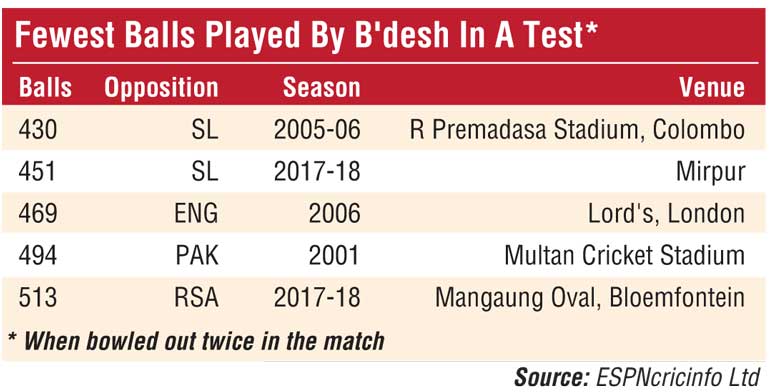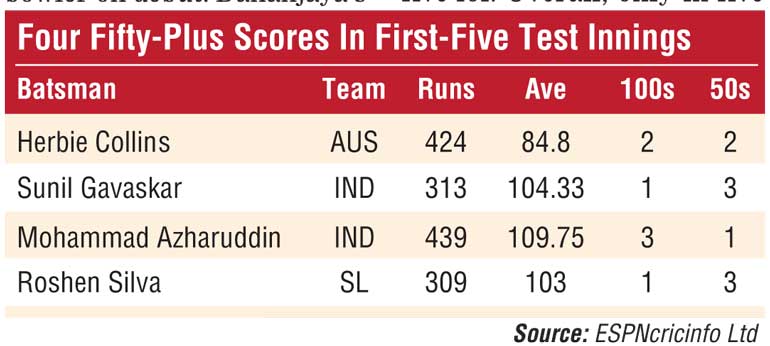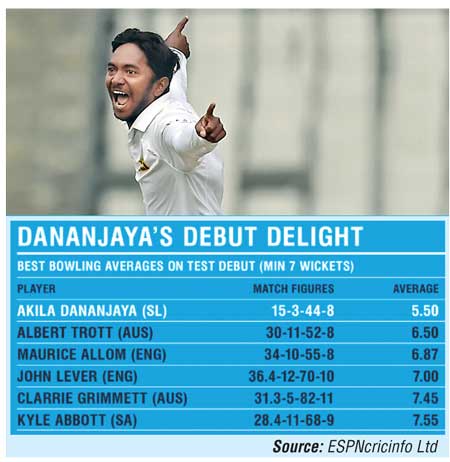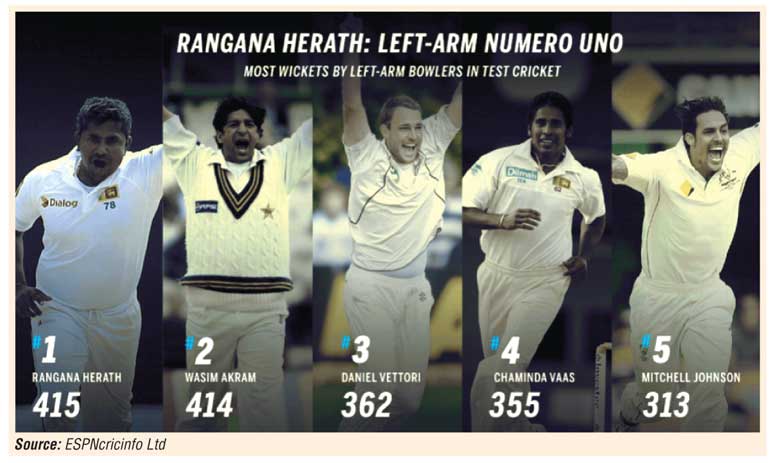Tuesday Mar 04, 2025
Tuesday Mar 04, 2025
Monday, 12 February 2018 00:22 - - {{hitsCtrl.values.hits}}




ESPNcricinfo: Rangana Herath went past Wasim Akram to become the most prolific left-arm bowler in Test history when he dismissed Bangladesh’s last wicket. Akram took 414 wickets at an average of 23.62 in 104 matches. Herath, on the other hand, was playing only the 89th Test of his career. New Zealand’s Daniel Vettori is third on this list with 362 wicket from 113 matches. Chaminda Vaas, Mitchell Johnson and Zaheer Khan are the only other left-armers to take at least 300 Tests wickets.
Herath lived up to his reputation of being a deadly bowler in the fourth innings of a Test, taking 4 for 49 in Bangladesh’s second innings. Including this innings, Herath’s last-ten fourth-innings bowling in Tests have fetched him 46 wickets at a frugal average of 12.52. Overall, Herath has taken 106 wickets at an average of 18.33 in fourth innings. His fourth-innings haul now equals Muttiah Muralitharan’s, whose wickets came at an average of 21.01. Only Shane Warne, with 138 wickets at an average 23.14, has taken more wickets in fourth innings of Tests than the Sri Lankan duo.
Roshen Silva’s impressive start
In Sri Lanka’s second innings, Roshen Silva showed excellent defensive technique and Test-match temperament to register his second fifty of the match in difficult batting conditions. Roshen had begun his career with a duck in his debut innings, but since then has made at least a fifty in each of the four innings he has batted in. This puts him in an exclusive club of batsmen who have made four fifty-plus scores in their first five Test innings. Australia’s Herbie Collins, India’s Sunil Gavaskar and Mohammad Azharuddin are the only other batsmen to have such a prolific start to their Test careers.
De Silva’s 309 runs, at an average of 103.00, is also the second most any Sri Lanka batsman has made in his first five innings. Asela Gunaratne had made 310 runs in the first-five innings of his Test career, which are the most.
Akila Dananjaya makes a historical debut
Akila Danajaya added a five-for in the second innings - thus becoming only the third Sri Lanka debutant to get a five-wicket haul - to his first innings haul of three wickets to end up with match figures of 8 for 44. These are the best match figures by a Sri Lanka bowler on debut. Dananjaya’s figure bettered the 8 for 132 that Ajantha Mendis took on his debut against India at the SSC, Colombo, in 2008.
Dananjaya’s average in this match of just 5.50 runs per wicket is the lowest in Test history when a debutant has taken eight or more wickets in the match. It betters the 6.50 runs-per-wicket average that Albert Trott returned on his debut against England in Adelaide in 1894-95. In fact, Dananjaya’s 5 for 24 in Bangladesh’s second innings is one of the cheapest five-fors by a debutant in Test history.
Bangladesh batsmen didn’t make Dananjaya work for his wickets, conceding five wickets in just the five overs that the debutant bowled in their second innings. His strike-rate of six balls per wickets in the third-best for a spinner in Test History to take a five-for. Overall, only in five other instances has a bowler been made to bowl fewer balls per wicket for his five-wicket haul.
Bangladesh batsmen fall like tenpins
The absence of any resistance from the Bangladesh batsmen meant that their second innings lasted just 29.3 overs. However, this innings ranks only the fourth-worst in terms of the number of overs Bangladesh have made the opposition bowl before being bowled out. The fewest they have lasted is 25.2 overs, which also came against Sri Lanka, in the first innings of the match in Colombo in 2007.
Bangladesh’s first innings in this match also wasn’t too long, and lasted only 45.4 overs. In total, they were bowled out twice in this match in only 451 balls, making it the second fewest balls they have lasted in a Test in which they have been bowled out twice. The fewest deliveries they have played in a Test is 430, which was against the same opposition in 2005-06.
Discover Kapruka, the leading online shopping platform in Sri Lanka, where you can conveniently send Gifts and Flowers to your loved ones for any event including Valentine ’s Day. Explore a wide range of popular Shopping Categories on Kapruka, including Toys, Groceries, Electronics, Birthday Cakes, Fruits, Chocolates, Flower Bouquets, Clothing, Watches, Lingerie, Gift Sets and Jewellery. Also if you’re interested in selling with Kapruka, Partner Central by Kapruka is the best solution to start with. Moreover, through Kapruka Global Shop, you can also enjoy the convenience of purchasing products from renowned platforms like Amazon and eBay and have them delivered to Sri Lanka.
Discover Kapruka, the leading online shopping platform in Sri Lanka, where you can conveniently send Gifts and Flowers to your loved ones for any event including Valentine ’s Day. Explore a wide range of popular Shopping Categories on Kapruka, including Toys, Groceries, Electronics, Birthday Cakes, Fruits, Chocolates, Flower Bouquets, Clothing, Watches, Lingerie, Gift Sets and Jewellery. Also if you’re interested in selling with Kapruka, Partner Central by Kapruka is the best solution to start with. Moreover, through Kapruka Global Shop, you can also enjoy the convenience of purchasing products from renowned platforms like Amazon and eBay and have them delivered to Sri Lanka.